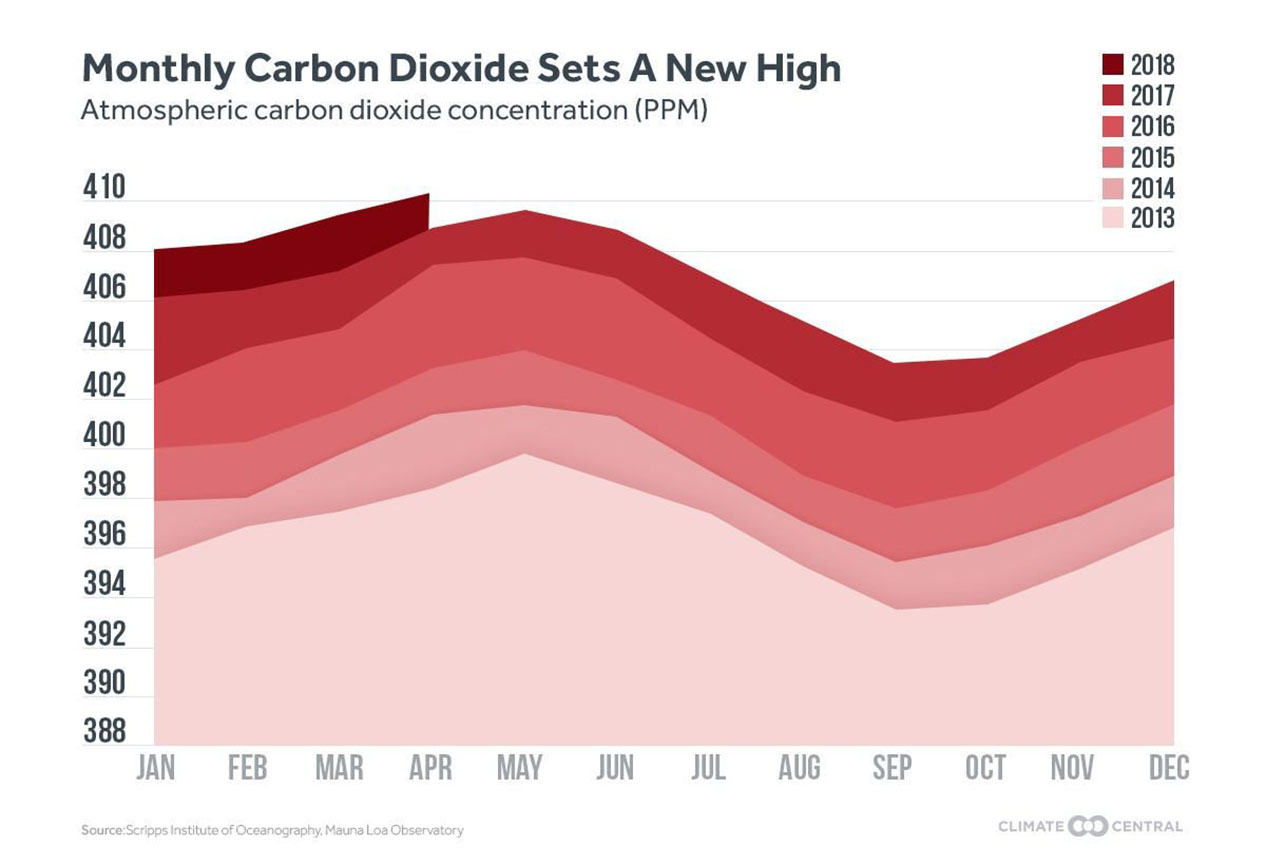What do we already know?
Project the image above, or the tweet below, on the board:
https://twitter.com/ClimateCentral/status/992468921403019264
Or, write on the board: Atmospheric carbon dioxide has set a new high — 410 parts per million in April 2018.
Ask students to think and write individually their responses to the following questions. After a few moments, ask volunteers to share their responses.
1. What is the greenhouse effect?
2. What is climate change?
3. What kinds of things produce atmospheric carbon dioxide (CO2)?
Alternatively, ask students, in small groups, to look at the graphic or tweet and discuss: What does this chart show? What does it mean? After a few moments, ask volunteers from each group to share their responses.
Next, introduce the central question for the lesson:
Why is the 410 parts per million (ppm) milestone worrying, and what can we do about it?
Analyzing the problem
Have students view this website, or give them a printout of it: https://mashable.com/2018/05/03/co2-highest-level-human-history/
Ask students to read the article individually, and write down or highlight the most concerning statistics, information, graphs, or ideas in the article.
In small groups, ask students to discuss: What do you find most concerning about this article?
Ask groups to share with the whole class the facts that concern them most, and record their responses. If students repeat points, add a checkmark to those points so everyone gets a sense of what is most concerning to the class.
What can we do about it?
Return to the initial question of the lesson:
Why is the 410 ppm milestone worrying, and what can we do about it?
Ask students to write a letter to the editor of their local paper about this climate change milestone. To research their letter, students may want to visit the website www.climatesignals.org. If there is time, do the extension activity below with students before they write their letter.
The letter should:
- mention that we have reached 410 ppm of atmospheric carbon and what that means
- explain how climate change will affect our future
- use personal details or stories to make the letter relatable
- argue for readers to take a particular course of action to fight climate change
Extension Activity:
Strategies to fight climate change
This optional extension activity can enrich the science, writing, or social studies aspects of the lesson, and prepare students to write a stronger letter to the editor.
Divide students into five groups. Each will research a different method for fighting climate change: scientific research, lawsuits, protests, lobbying, and personal habit change. Give each group a handout or a link to begin their research (see below). Ask each group to answer the following questions:
- What is your group’s method for fighting climate change?
- What does this method look like in action?
- What would need to happen or change for this method to be successful?
- What are the benefits of this method?
- What are the challenges or problems with this method?
- How effective has this method been so far?
- Could this method, by itself, solve the problem of carbon emissions and climate change?
Next, ask students to create a skit demonstrating what this method looks like in action, and present their skits to the class.
Finally, integrate students’ learning by discussing these questions:
- What method is easiest?
- What method is most effective?
- Which methods might work well together?
- Which method or methods should we focus our time and energy on?
Handouts:
Group 1: Scientific research
This article focuses on technology for removing carbon from the atmosphere. If the group has time, they may wish to also research green technology that prevents future carbon emissions, including solar and wind technology and electric cars.
https://www.washingtonpost.com/news/theworldpost/wp/2018/01/08/carbon-emissions/
Group 2: Lawsuits
Several climate lawsuits have been brought by children. The article focuses on one of the most recent of these.
https://www.miamiherald.com/news/local/environment/article208967284.html
Group 3: Protests
350.org uses many strategies, but students should particularly notice how they conduct direct, confrontational, public, large-scale actions.
Group 4: Lobbying
Students should notice how Citizens Climate Lobby has a laser focus on a particular legislative proposal, carbon fee and dividend, and how they appeal to legislators directly through meetings and letters to the editor.
https://citizensclimatelobby.org/about-ccl/levers-of-political-will/
Group 5: Personal habit change
Note that this website has been archived and is not on the EPA’s current site along with most other information on climate change. You might ask students why they think this was done and what effect that might have.
https://19january2017snapshot.epa.gov/climatechange/what-you-can-do-home_.html
